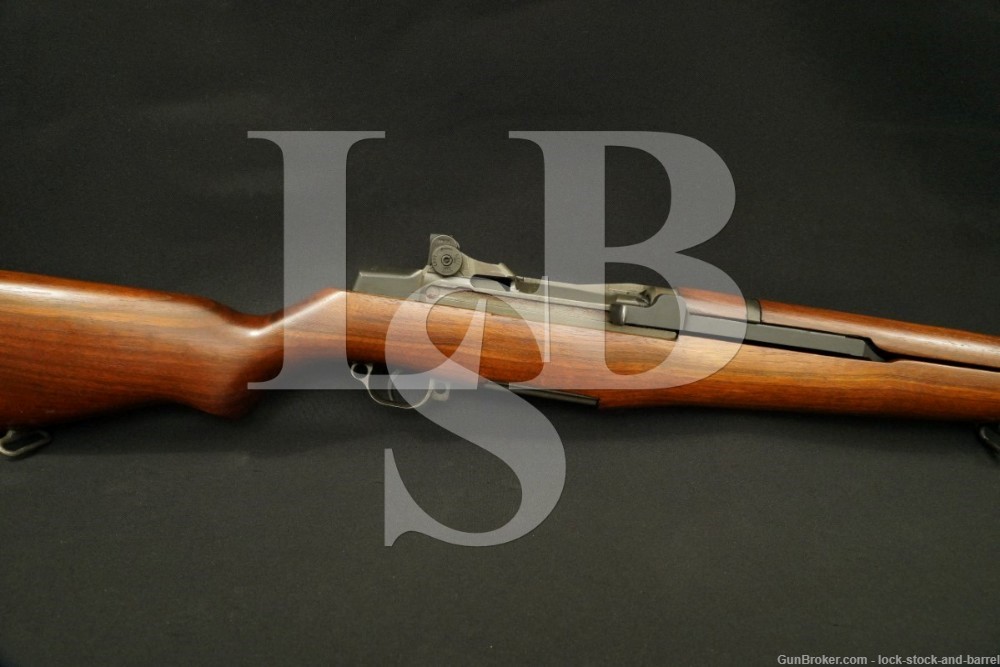
Springfield M1 Garand 308 Conversion NM Sights Semi Automatic Rifle Modern
SOLD FOR: $1825
LSB#: 211003NI05
Make: Springfield Armory
Model: M1 Garand Modern .308 Conversion
Serial Number: 1181993
Year of Manufacture: ATF Modern
February, 1943 (page 186 of Joe Poyer’s M1 GARAND 1936 to 1957, 6th Edition). Barrel Date: June, 1993
Caliber: .308 Winchester (7.62x51mm)
Action Type: Semi Auto, En Bloc Clip Fed
Markings: There is no import mark.
Receiver: “U.S. RIFLE / CAL. .30 M1 / SPRINGFIELD / ARMORY / 1181993”
Trigger Group: 6528290-SA”- A Springfield part (page 90 of Joe Poyer’s M1 GARAND 1936 to 1957, 6th Edition).
Hammer: “C46008-7 SA”– A Springfield part (page 98).
Safety: “SA-11” – A Springfield part (page 103).
Follower: “13” – Used by Springfield and Winchester (page 83).
Receiver Leg: “8 7 A diamond” and “D 28291 17” – Correct for the Springfield serial number (page 29).
Op Rod: “6535382 SA” – A Springfield part (page 71).
Barrel: “4GR 10 308 WIN. 6 93 1” – A commercial production (June, 1993) barrel chambered in .308 Winchester.
Bolt:“D28287-19SA / A-8”- A Springfield part (page 53).
The stock and sights are described below.
Barrel Length: Approximately 24 Inches
Sights / Optics: National Match sights are installed.
The left front sight wing is marked “NM / 062”. The left rear sight wing is marked “NM/2A”. The windage knob is marked “NM”. The face of the aperture’s riser is marked “NM”. The top of the aperture is marked “520”.
The front sight is a blade set between two protective wings. The rear sight is a fully adjustable aperture sight set between two protective wings. The windage knob is marked “LEFT arrow” twice and “GMI”. The elevation knob is marked from “2-12” in increments of two and “WCE” on the edge.
Stock Configuration & Condition: The interior of the forearm is painted with the serial number.
The wood has been built up with a bedding compound to better fit the action and the trigger group.
The hardwood stock has a pistol grip, metal nose caps, a stacking loop, two sling loops and a metal buttplate with hinged door for storage in the butt. The buttplate shows light surface erosion and a brown patina. The left side of the stock shows an area of scratches below the receiver. The wood shows small light scrapes & handling marks. The LOP measures 13 ? inches from the front of the trigger to the back of the buttplate. The stock rates in about Very Good Plus to Fine overall condition.
Type of Finish: Parkerized, Blue Barrel
Finish Originality: Refinished
Bore Condition: The area near the muzzle is semi bright. The remainder of the bore shines. The rifling is sharp. There is fouling and light erosion near the muzzle. The fouling should clean up some. The bore shows an M.E. of 1.2.
Overall Condition: This rifle retains about 92% of its metal finish, as refinished. The bottom rear of the receiver has pin prick surface erosion showing through the new finish.The area also shows light thinning. The bottom of the receiver has oxidation bleeding through the new finish. The receiver legs and trigger group show light thinning. The bottom rear of the barrel shows thinning. The rear of the receiver shows discoloration. The right side of the receiver & front of the bolt show light thinning consistent with cycling the action. The markings are deep. Overall, this rifle rates in about Very Good Plus to Fine condition as refinished.
Mechanics: The action functions correctly. We did not fire this rifle. As with all used firearms, a thorough cleaning may be necessary to meet your maintenance requirements.
A metal spacer block has been installed to prevent the loading of .30-06 into this .308 M1 Garand.
Box, Paperwork & Accessories: None
Our Assessment: The U.S. Rifle, Caliber .30, M1 is known affectionately as “the Garand” after its inventor, John Garand. The rifle would become the first standard-issue semi-automatic infantry rifle in the world. While some countries entered the war with limited issued semi-automatic rifles or developed such rifles during the war, America was the only nation to enter with its Army issuing autoloading rifles on a large scale. General Patton famously referred to the rifle as “the greatest battle implement ever devised”. Millions were produced during WWII and hundreds of thousands afterward, seeing use through the Korean War and into the Vietnam War. Interestingly, while many other weapons and military items would see production contracts sent out to otherwise non-related companies, during WWII production remained with Springfield Armory and Winchester. It was only after the war that production would be contracted out to another gunmaker, Harrington & Richardson, as well as the agricultural equipment maker, International Harvester.
This Springfield Armory M1 Garand originally was made back in 1943. It has since been rebuilt using Springfield parts and a commercial barrel chambered in .308 Winchester. It also has a few upgrades. National Match sights have been installed. The wood has been built up with a bedding compound to better fit the action and the trigger group. A metal spacer block has been installed to prevent the loading of .30-06 into the rifle.
The rifle’s metal has been refinished so it looks impressive for a WWII Military rifle.
We don’t know who rebuilt the rifle or when it was rebuilt so, sorry no C&R.

